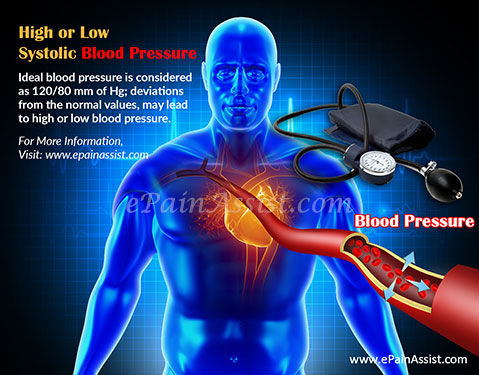Blood pressure is the pressure exerted by the flowing blood on the walls of the arteries carrying them. It is represented with two numbers, the first number, which is higher, is called systolic pressure, while the second number, which is lower is called diastolic pressure. Ideal blood pressure is considered as 120/80 mm of Hg; deviations from the normal values, may lead to high or low blood pressure.
High or Low Systolic Blood Pressure
Sometimes only the first number or the systolic pressure may be high or low, while the diastolic pressure remains normal. It is termed as systolic hypertension, when diastolic remains less than 90 mm of Hg, but the systolic pressure is above 140 mm of Hg. Low systolic blood pressure is noted in case of hypotension, when the blood pressure drops below 100/60 mm of Hg. Higher systolic blood pressure may indicate underlying problems related to heart, circulatory system or thyroid.
What Does High Systolic Blood Pressure Indicate?
It is important to pay attention to systolic blood pressure, especially in elderly people, women and those with existing ailments. High systolic blood pressure is seen more in presence of existing cardiovascular problems. This is particularly noted in aging people where stiffness of large arteries begins, when the larger arteries like aorta are unable to function efficiently. High systolic blood pressure can also occur in cases of heart valve disorders or those with hyperthyroidism (which is seen in an overactive thyroid).
In general, isolated systolic high blood pressure increases the risk for heart disorders, stroke and damage to organs like brain, kidney and eyes.
Treatment for High Systolic Blood Pressure
It is important to assess this situation and manage it effectively as administration of blood pressure lowering medicines, can further reduce the already normal diastolic pressure. In such instances, the risk of lowering blood pressure increases and potentially increases the risk of further health problems. The goal of isolated systolic hypertension is to maintain a systolic blood pressure at or below 140 mm Hg while keeping the diastolic blood pressure at or above 70 mm Hg.
The principle of treating isolated systolic hypertension is to protect and prolong the damage that can be caused to heart, kidneys, brain and circulatory system. Treatments includes administering blood pressure lowering medications in appropriate doses so as to maintain a balance of systolic and diastolic blood pressure. Medicines used to lower blood pressure include diuretics, ACE inhibitors, Beta-blockers and calcium channel blockers.
Dietary changes and lifestyle modifications are advised, which include low sodium diet (reduced salt intake), stopping smoking and limiting alcohol intake, regular exercise or physical activity and stress management. Losing and maintaining weight is an important part of managing high blood pressure. As suggested by DASH diet for hypertension, diet should include more of complex carbohydrates, fruits, vegetables, reduced salt and limited intake of sugar, and fats.
What Does Low Systolic Blood Pressure Indicate?
Low systolic blood pressure is seen when blood pressure drops below the normal values and is termed as hypotension. Slightly lower side of systolic blood pressure may be normal in few individuals however, persistently low systolic blood pressure may indicate underlying health problems. When blood pressure drops too low, it can affect the amount of blood reaching the brain and major organs.
Low blood pressure may be noted during normal times like at resting state or in people who are naturally active, healthy and relaxed. Low blood pressure may be seen on changing posture, standing up from a lying down position, called orthostatic (postural) hypotension or may be present after having food, commonly called as postprandial hypotension. In certain conditions like loss of fluids or dehydration after diarrhoea, vomiting or in anemia, prolonged periods of bedrest, pregnancy, certain neurological or hormonal conditions and heart disorders, low systolic blood pressure may be noted.
In case of low blood pressure, symptoms like dizziness, fainting and light headedness may be felt. Cold skin, sweating, fatigue, difficulty in concentration, blurry vision and even loss of consciousness can occur. Severely low blood pressure is considered as a state of shock and needs immediate medical attention.
Treatment for Low Systolic Blood Pressure
Hypotension is treated based on the cause, but generally includes increasing the fluid intake along with salts and maintaining an electrolyte balance. Other measures include, making slow movements, avoidance of hurried change of positions and gradually moving from sleeping to standing position, in case of orthostatic or postural hypotension.
Weight maintenance, stress management, proper dietary intake, having food at regular intervals and increasing water intake to maintain hydration is important. Management may also include wearing leg stockings, to avoid hypotension, if varicose veins are present.

